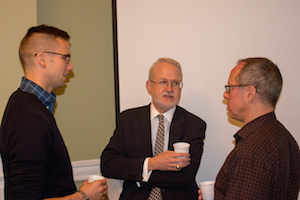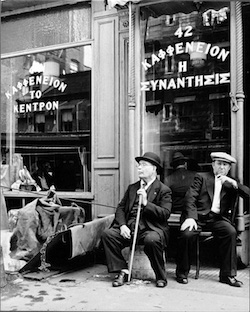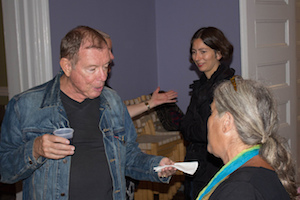
Crisis Averted!
Preservationists had a close call when, just before Thanksgiving, the NYC Landmarks Preservation Commission announced their proposal to remove 100 calendared buildings and districts from consideration for landmarking. By calendaring these sites in the first place, LPC had already deemed them historic and worthy of public hearing for landmark designation. Once “de-calendared”, these properties, many of which are widely known, would be vulnerable to demolition. When the announcement was made, preservationists, community activists, and elected officials quickly and loudly protested. Then, just a few days before the scheduled December 9 vote, LPC tabled the proposal until further notice.

“The LPC deserves great recognition for listening to New Yorkers and backing off from that proposal,” said Richard Moses, LESPI’s Board President. “The LPC plays an essential role in maintaining our city’s historic fabric and architectural treasures, and we are thankful for their responsiveness to the community.”
Two East Village / Lower East Side buildings – 138 Second Avenue and 2 Oliver Street – would have been among those ‘de-calendared’. No. 138 was originally built in the early 19th century when this area of Second Avenue was a wealthy residential precinct. By 1885 the building had become the Association for Befriending Children and Young Girls, reflecting the area’s transition to a more struggling German immigrant neighborhood – Kleindeutschland. A 2013 NY Times article on the avenue’s history by Christopher Gray notes that the building “boasts a very nice surviving brownstone doorway with a Gibbs [i.e. Georgian style] surround.” No. 2 Oliver Street, built in 1832, is one of a handful of early 19th century Federal-style houses that survive today.

LESPI spoke out emphatically in opposition to LPC’s proposal. In our December 3 letter we urged the LPC to properly consider calendared sites for landmarking following the time tested process of public hearing and vote based on individual merit. This approach is essentially transparent, and allows for community input and public investiture in protecting our city’s irreplaceable historic buildings and neighborhoods.
Anthony Wood Speaks on Preservation Advocacy
Remember the importance of coalitions – and don’t forget the politics. These are among the many words of wisdom imparted by esteemed preservationist Anthony Wood at his LESPI lecture “A Century of Preservation Advocacy: Lessons for Today” in November.

The author of “Preserving New York: Winning the Right to Protect A City’s Landmarks”, Tony took us on a journey through over 100 years of New York preservation history, highlighting our movement’s successes (Castle Clinton) and failures (the Brokaw Mansions), and the lessons we must draw from each.
Preservationists must establish broad coalitions if we hope to protect historic structures from destruction, according to Tony. For example, Castle Clinton, built in 1808 at the tip of Lower Manhattan to prevent British invasion, was saved from Robert Moses’s wrecking ball by a coalition of 18 organizations that shrewdly utilized the levers of city, state and federal government. Ultimately the historic fort was saved – just barely – after a years-long stand-off with Moses. We thank Tony for his riveting presentation!

Pinning History on Pinterest
Say you’d like to see a photo of:
– Feast of San Gennero in 1948
– Writer Jack Kerouac at Tompkins Square Park, 1953
– Third Avenue El train in 1949
– Asian American girls in Chinatown in 1965
– Horse drawn street cars, the Bowery near Canal St.
– Orchard Street during the 1970s
– Pushcarts on Hester Street in 1903
– Grateful Dead playing in Tompkins Square Park, 1967
– Rag picker’s row, an alley off Baxter Street, in 1890
– Madonna in the East Village ca. 1982
– Sammy’s night club on the Bowery, 1930
– General Slocum steamship disaster in 1904
– The Ramones in front of CBGB

Or you’d like to see some Lower East Side artwork:
– David Leonard’s painting of Division St.
– Rebecca Lepkoff’s Lower East Side photographs
– Keith Haring and Kenny Scharf murals on Houston St.
– Yiddish Theater posters
– Berenice Abbot photos of the 1930s and 40s
– Lithograph of Manhattan Street, early 19th century
– Wigstock poster featuring Lady Bunny, 1989
– George Bellows’s painting The Cliff Dwellers of 1913

Check out our Pinterest site to see these and much more…more than 800 in total! And “Follow” LESPI in Pinterest to keep up with the “new” historic images we keep adding all the time.
Join LESPI for 2015!
Your $20 membership dues help us work to preserve the historic East Village / Lower East Side. Or donate more: all donations are tax deductible as allowed by law. See HERE to donate. Thank you!
Support LESPI!
Donate!
Please donate to LESPI to help us in our work to preserve the historic East Village / Lower East Side! To donate, see HERE.
Or you can write a check to “FCNY/LESPI” and mail it to LESPI, c/o Neighborhood Preservation Center, 232 East 11th Street, New York, NY 10003. All donations are tax deductible as allowed by law.
Volunteer!
We’re looking for people to help with outreach, people with specialized skills and experience, monetary donations, and any other assistance that can help further our mission. We’d very much appreciate your help in our campaign to preserve the East Village / Lower East Side and hope to hear from you in the near future. Contact us at info@lespi-nyc.org.
Stay in Touch!
Go to “Lower East Side Preservation Initiative” on Facebook and check out our site! If you click the “Like” button you’ll receive periodic preservation, history and architectural updates for the LES/EV. You’ll also be showing support for our cause!
LESPI’s “Greeks in the Lower East Side” Lecture Event Brings the Past Present

Why did so many Jewish Greek citizens of the late 19th and early 20th century leave their beautiful homeland, cross an angry ocean, and arrive at a distant and unknown land to make a new life? For the same reason that so many millions of other immigrants originally came and still come to this country – economic opportunity. When the Greek immigrants arrived they shared their Lower East Side community with other Jewish people from distant lands – primarily Russia, Eastern Europe, and Germany, but due to language barriers and cultural differences had to rely primarily on themselves, settling in the area around Broome and Allen Streets. It was here, in 1927 that they built Kehila Kedosha Janina synagogue, which today still stands, beautifully preserved and restored inside and out, proudly serving a thriving Greek-American congregation.
Kehila Kedosha Museum Director and LESPI board member Marcia Ikonomopoulos’s lecture “Greeks in the Lower East Side – American Stories” in October provided a rich account of this community’s history and

life. Wonderfully, the packed-house audience included many descendants of the families Marcia discussed in her talk. Marcia’s relaxed delivery, though filled with historical information illustrated with archival photographs, transported the audience, as if we were sitting around the family dining table, listening to tales of our family’s past descendants.

Tifereth Israel Town and Village Synagogue Building Landmarked!
Some phenomenal news: in October, the Tifereth Israel Town and Village Synagogue building on East 14th Street was designated an Individual Landmark by the NYC Landmarks Preservation Commission. The building was constructed in 1866 as the German Baptist Church at what was then the outskirts of the Lower East Side’s Kleindeutschland neighborhood. Its transformation over time – from its original use to its conversion to the Ukrainian Orthodox Church in 1926, and finally to its conversion to its present use as Tifereth Israel Town and Village synagogue in 1962 – can be traced in the subtle changes in the building facade, most notably with the replacement of the steeples with onion domes by the Ukrainian church, and the introduction of the stained glass Star of David motif by the synagogue.
The building’s importance was recognized by the LPC in its very early days as a city agency when in 1966 it calendared the property for public hearing. LESPI along with other preservation and community groups urged landmark designation after word spread that the building might be threatened. We applaud the Commission’s vote to landmark and thereby save this important historic structure for our and future generations to appreciate, enjoy, and learn from.

Who We Are
LESPI Board Profiles: Carolyn Ratcliffe
Too often, the public thinks of volunteer preservation organizations as mysterious entities with lives of their own. But they’re actually composed of unique individuals. For this reason, we want to introduce you to our Board of Directors. Each LESPI quarterly newsletter highlights one of our Board members. For our Autumn 2014 newsletter, we are highlighting Carolyn Ratcliffe, Vice President of LESPI since 2008.

Carolyn serves as our Events Chair, bringing to LESPI her vast experience organizing events and raising funds for not-for-profits. Carolyn received her B.A. as an Art Major with a Minor in History from University of Alabama at Tuscaloosa, and went on to earn her Master of Science in Nonprofit Management from the Robert J. Milano Graduate School of Management and Urban Policy, The New School, in New York City.
Carolyn grew up in Natchez, Mississippi, one of the oldest and most historically important settlements in the Mississippi River Valley, with a grandmother who was deeply involved in local preservation and who nurtured Carolyn’s passion: “you could say that my interest in preservation has a lot to do with where I grew up and my family’s interests.”
Living in the East Village / Lower East Side, Carolyn has always been active, and often instrumental, in preserving what is important in this special neighborhood. She has served on Manhattan Community Board #3 since 2006, and is presently the Chair of the Arts & Culture Subcommittee and Chair of the Landmarks Subcommittee. She is the curator of the Annual LES Festival of the Arts, Theater for the New City. Among her many awards, she received the Westside Community Garden Community Garden Activist Award in June 2013.
One of the great victories for the historic East Village was the restoration of St. Brigid’s Church on Avenue B, overlooking Tompkins Square Park. Carolyn co-founded the Committee to Save St. Brigid and mobilized community support: this iconic mid 19th century church, reportedly built by Irish shipwrights, was literally saved from the wrecking ball after the 11th hour, when demolition had just begun. It has since been beautifully restored inside and out. Carolyn is particularly proud of her work in preserving La Plaza Cultural, an historic community garden. She is presently advocating for a community garden district to preserve all the gardens of the East Village / Lower East Side.
Carolyn’s expertise and experience launched LESPI from a more informal group of advocates to a not-for-profit 501(c)(3) corporation with a web site, printed literature, and all the trappings of an established volunteer organization. LESPI is indeed lucky to be the recipient of Carolyn’s knowledge and passion.
LESPI T-Shirts Now On Sale!
Wear a beautiful LESPI t-shirt to show your support for preservation of the historic East Village / Lower East Side! See HERE for purchase information. All proceeds go toward supporting LESPI’s work.

T-shirts are Hanes heavy duty 100% cotton.
About LESPI
LESPI is a grass roots, all-volunteer not-for-profit corporation in NY State formed in 2007 to urge the NYC Landmarks Preservation Commission to designate as historic districts intact portions of the East Village / Lower East Side. Our strategy includes documenting and mapping the historic streetscapes, starting with the East Village and Lower East Side below Houston Street, and rallying community residents, city officials and the LPC to effect landmark designation. LESPI is a not-for-profit corporation in the State of New York. Our fiscal sponsor is Fund for the City of New York.
Contact us by email at info@lespi-nyc.org, or use the form through our web site lespi-nyc.org, or by mail at LESPI, c/o Neighborhood Preservation Center, 232 East 11th Street, New York, NY 10003.